Get Free NCERT Solutions for Class 11 Maths Chapter 12 Introduction to three Dimensional Geometry Ex 12.3 PDF in Hindi and English Medium. Introduction to three Dimensional Geometry Class 11 Maths NCERT Solutions are extremely helpful while doing your homework. Introduction to three Dimensional Geometry Ex 12.3 Class 11 Maths NCERT Solutions were prepared by Experienced LearnCBSE.online Teachers. Detailed answers of all the questions in Chapter 12 Class 11 Introduction to three Dimensional Geometry Ex 12.3 provided in NCERT Textbook.
- Introduction to Three Dimensional Geometry Class 11 Ex 12.1
- Introduction to Three Dimensional Geometry Ex 12.2
- Introduction to Three Dimensional Geometry Ex 12.3
- Introduction to Three Dimensional Geometry Miscellaneous Exercise
- त्रिविमीय ज्यामिति का परिचय प्रश्नावली 12.1 का हल हिंदी में
- त्रिविमीय ज्यामिति का परिचय प्रश्नावली 12.2 का हल हिंदी में
- त्रिविमीय ज्यामिति का परिचय प्रश्नावली 12.3 का हल हिंदी में
- त्रिविमीय ज्यामिति का परिचय विविध प्रश्नावली का हल हिंदी में
- Introduction to Three Dimensional Geometry Class 11 Notes
- NCERT Exemplar Class 11 Maths Introduction to Three Dimensional Geometry
- Three Dimensional Geometry JEE Main Mathematics Previous Year Questions
Free download NCERT Solutions for Class 11 Maths Chapter 12 Introduction to three Dimensional Geometry Ex 12.3 PDF in Hindi Medium as well as in English Medium for CBSE, Uttarakhand, Bihar, MP Board, Gujarat Board, BIE, Intermediate and UP Board students, who are using NCERT Books based on updated CBSE Syllabus for the session 2019-20.
NCERT Solutions for Class 11 Maths Chapter 12 Exercise 12.3
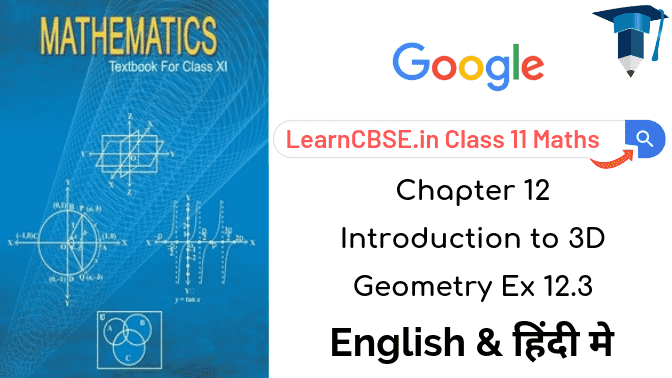
Question 1.
Find the coordinates of the point which divides the line segment joining the points (-2, 3, 5) and (1, -4, 6) in the ratio
(i)
2 : 3 internally,
(ii)
2 : 3 externally
Solution:
(i)
Let P(x, y, z) be any point which divides the line segment joining the points A(-2, 3, 5) and B(1, -4, 6) in the ratio 2 : 3 internally.
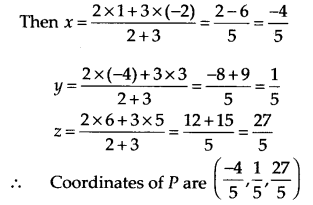
(ii)
Let P(x, y, z) be any point which divides the line segment joining the points 71 (-2, 3, 5) and B(1, -4, 6) in the ratio 2 : 3 externally. Then
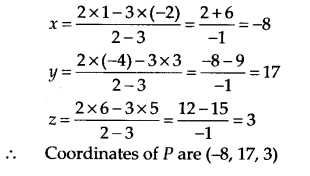
Question 2.
Given that P(3, 2, -4), Q(5, 4, -6) and R(9, 8, -10) are collinear. Find the ratio in which Q divides PR.
Solution:
Let Q(5, 4, -6) divides the line segment joining the points P(3, 2, -4) and R(9, 8, -10) in the ratio k : 1 internally.
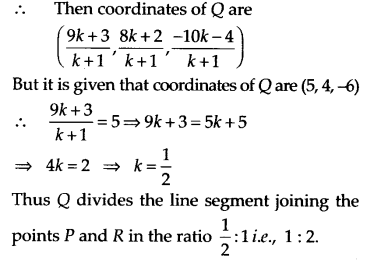
Question 3.
Find the ratio in which the YZ-plane divides the line segment formed by joining the points (-2, 4, 7) and (3, -5, 8).
Solution:
Let the line segment joining the points A(-2, 4, 7) and B(3, -5, 8) be divided by the YZ -plane at a point C in the ratio k : 1.
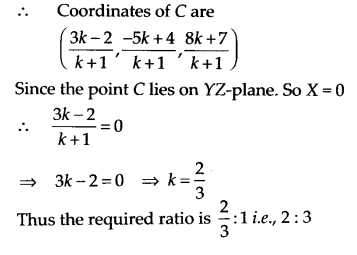
Question 4.
Using section formula, show that the points A(2, -3, 4), B(-1, 2, 1) and C\(\left( 0,\frac { 1 }{ 3 } ,2 \right) \) are collinear.
Solution:
Let the points A(2, -3, 4), B(-l, 2,1) and C\(\left( 0,\frac { 1 }{ 3 } ,2 \right) \) be the given points. Let the point P divides AB in the ratio k : 1. Then coordinates of P are \(\left( \frac { -k+2 }{ k+1 } ,\frac { 2k-3 }{ k+1 } ,\frac { k+4 }{ k+1 } \right) \)
Let us examine whether for some value of k, the point P coincides with point C.
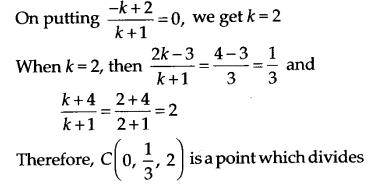
AB internally in the ratio 2:1. Hence A, B, C are collinear.
Question 5.
Find the coordinates of the points which trisect the line segment joining the points P(4, 2, -6) and Q(10, -16, 6).
Solution:
Let R and S be two points which trisect the line segment PQ.
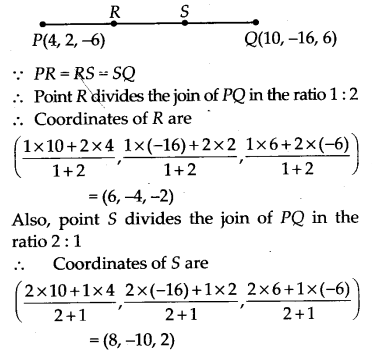
NCERT Solutions for Class 11 Maths Chapter 12 Introduction to Three Dimensional Geometry (त्रिविमीय ज्यामिति का परिचय) Hindi Medium Ex 12.3
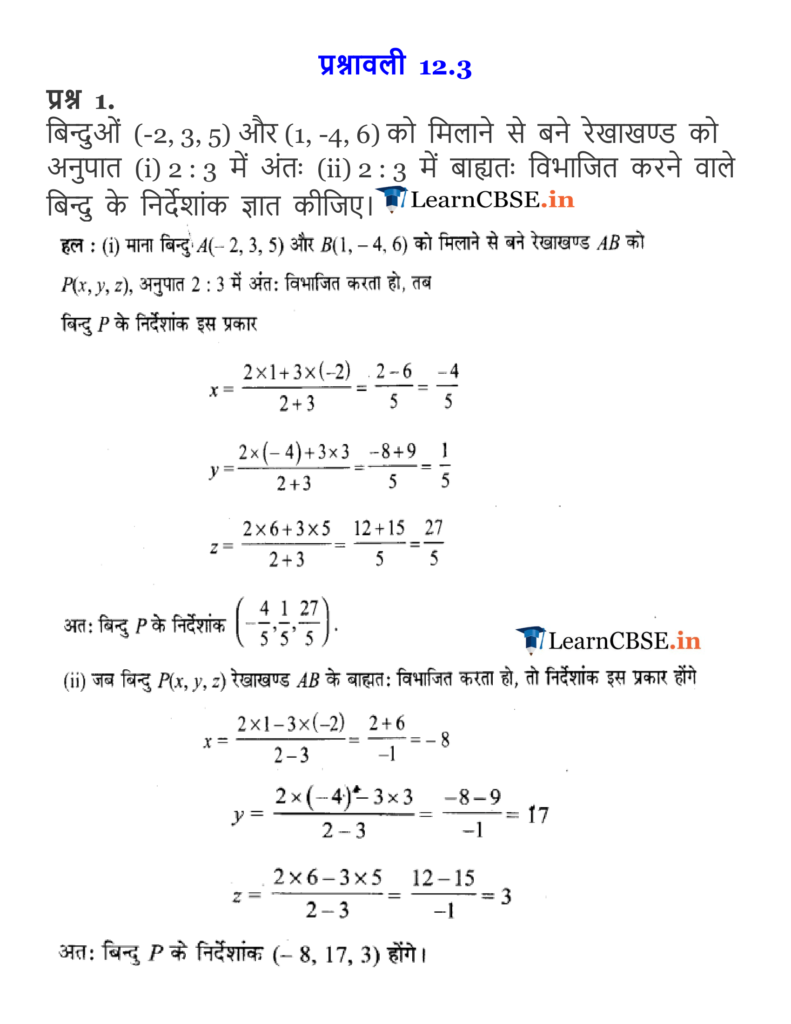
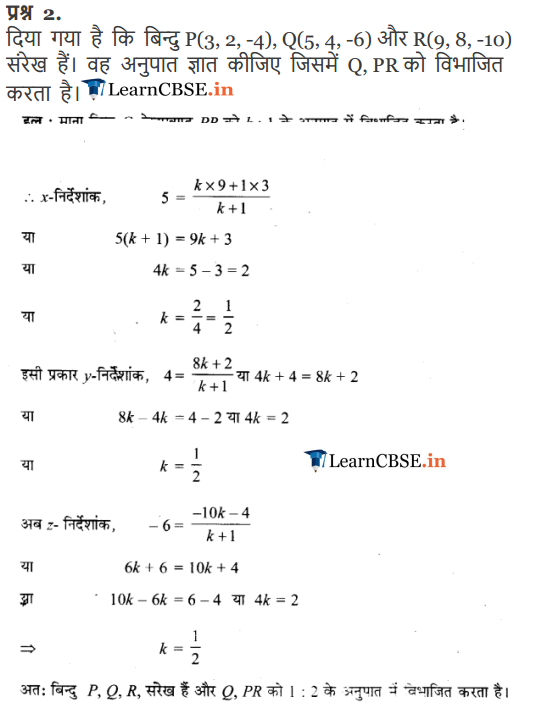
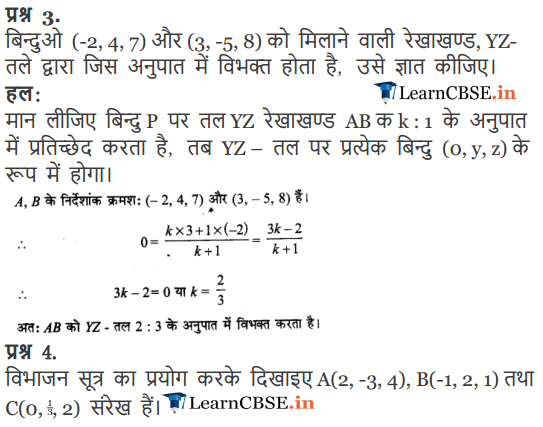
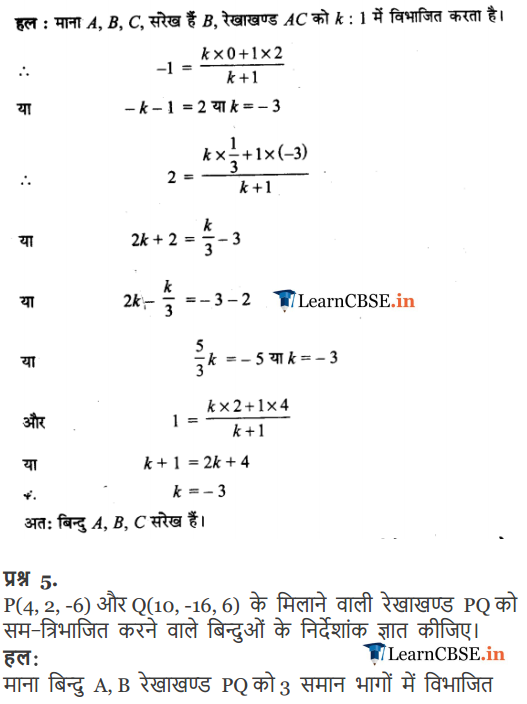
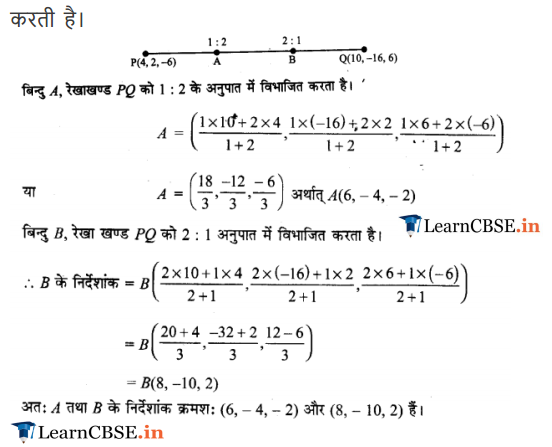
NCERT Solutions for Class 11 Maths All Chapters
- Chapter 1 Sets
- Chapter 2 Relations and Functions
- Chapter 3 Trigonometric Functions
- Chapter 4 Principle of Mathematical Induction
- Chapter 5 Complex Numbers and Quadratic Equations
- Chapter 6 Linear Inequalities
- Chapter 7 Permutation and Combinations
- Chapter 8 Binomial Theorem
- Chapter 9 Sequences and Series
- Chapter 10 Straight Lines
- Chapter 11 Conic Sections
- Chapter 12 Introduction to Three Dimensional Geometry
- Chapter 13 Limits and Derivatives
- Chapter 14 Mathematical Reasoning
- Chapter 15 Statistics
- Chapter 16 Probability